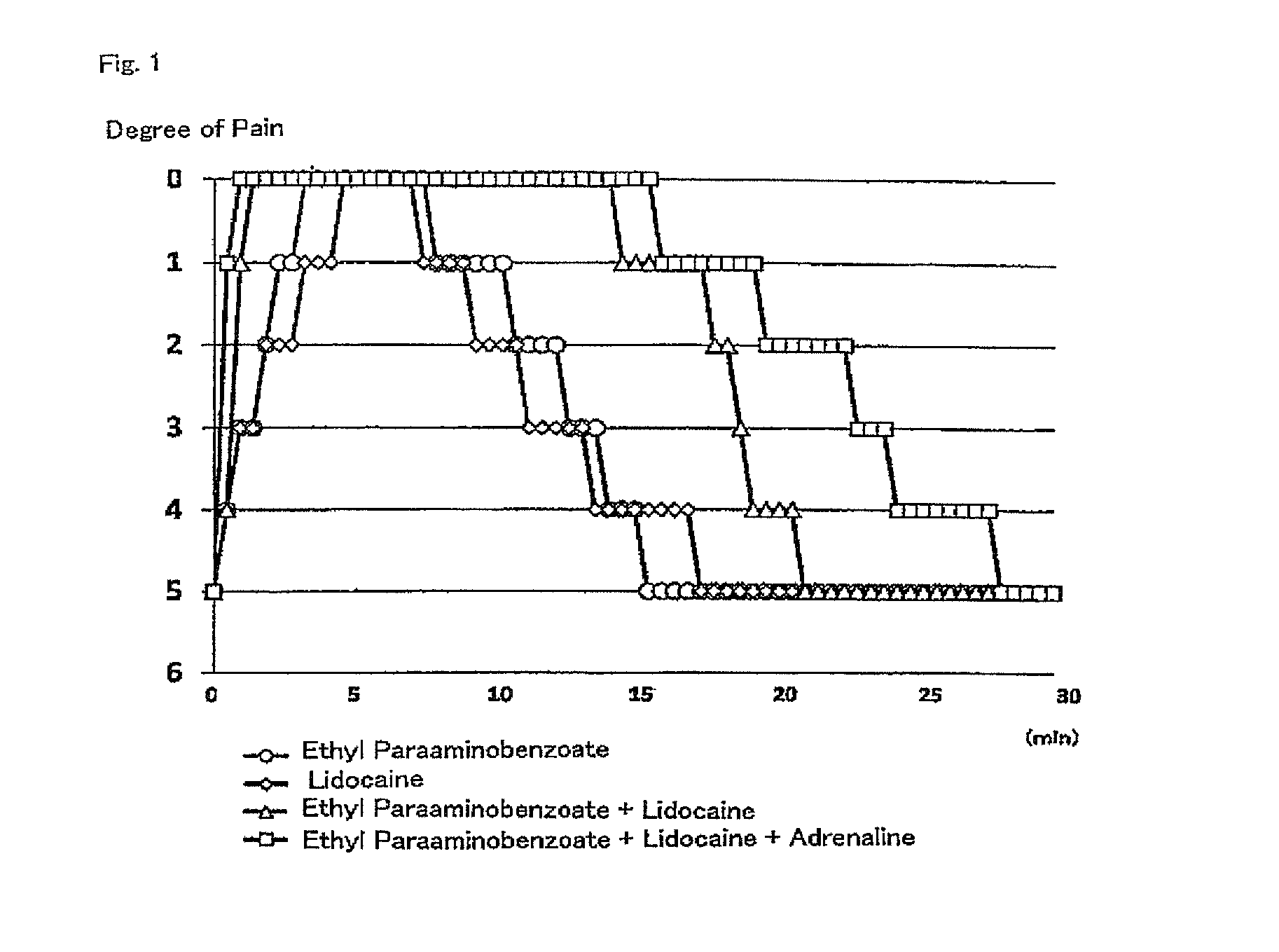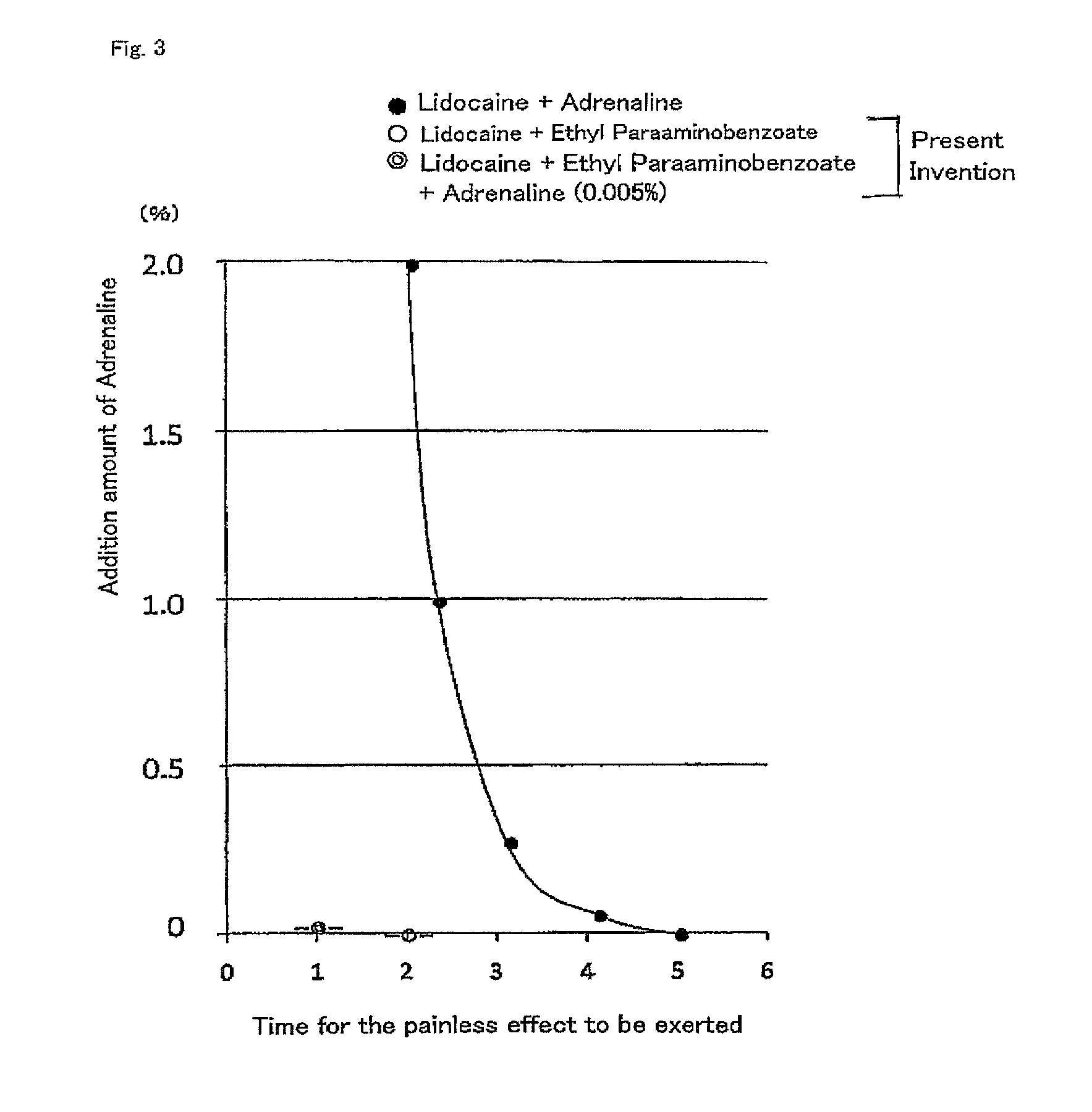Surface anesthetic agent
a surface anesthetic and anesthetic technology, applied in the field of surface anesthetic agents, can solve the problems of wasting time, giving patients pain, and affecting the effect of pain,
- Summary
- Abstract
- Description
- Claims
- Application Information
AI Technical Summary
Benefits of technology
Problems solved by technology
Method used
Image
Examples
example 1
[0038](1) As a sample of ethyl paraaminobenzoate alone (Comparative Example 1-1), 200 mg Hurricaine Gel (40 mg ethyl paraaminobenzoate) was attached to a cotton swab, and applied to the buccal mucosal membrane.
[0039](2) As a sample of lidocaine alone (Comparative Example 1-2), 200 mg Xylocaine jelly (4 mg lidocaine) was attached to a cotton swab, and applied to the buccal mucosal membrane.
[0040](3) As a sample of a combination use of ethyl paraaminobenzoate and lidocaine (Example 1-1), 200 mg of a mixture of Hurricaine Gel and Xylocaine jelly in an equal amount (20 mg ethyl paraaminobenzoate and 2 mg lidocaine) was attached to a cotton swab, and applied to the buccal mucosal membrane.
[0041](4) As a sample of a triple combination use of ethyl paraaminobenzoate, lidocaine and adrenaline (Example 1-2), 200 mg of a mixture of Hurricaine Gel and Xylocaine jelly in an equal amount (20 mg ethyl paraaminobenzoate and 2 mg lidocaine) and 10 mg adrenaline liquid (0.01 mg adrenaline) was attac...
example 2
[0043]Next, the relation of the blending ratio of lidocaine and ethyl paraaminobenzoate with the fast-acting property of the surface anesthetic action was studied. By varying the blending ratio of Xylocaine jelly and Hurricaine Gel, various surface anesthetic agents of lidocaine and ethyl paraaminobenzoate in mass ratios of 0:100 to 100:0 were prepared. For example, various surface anesthetic agents of lidocaine and ethyl paraaminobenzoate in mass ratios of 0:100, 1:99, 3:97, 6:94, 19:81, 31:69, 47:53, 80:20 and 100:0, were prepared by blending Xylocaine jelly and Hurricaine Gel in ratios of 0:200, 16:184, 50:150, 80:120, 140:60, 164:36, 180:20, 195:5 and 200:0, respectively. 200 mg of each of the prepared surface anesthetic agents, was applied to the buccal mucosal membrane similarly to Example 1, and then a needle was stabbed, and the time for the painless effect to be exerted was measured. The relation of the time for the painless effect to be exerted and the mass ratio of lidoca...
example 3
[0045]To 4 mg lidocaine (Xylocaine jelly used in Example 1), 0 mg (0% by mass), 0.002 mg (0.05% by mass), 0.01 mg (0.25% by mass), 0.04 mg (1.0% by mass), and 0.08 mg (2.0% by mass) of adrenaline were added respectively, and the time until the surface anesthesia started to work was measured in each case. The application method and the measurement method for the results were carried out similar to those in Example 1. The results are shown in FIG. 3. In FIG. 3, besides lidocaine+adrenaline (-●-), the values of 20 mg ethyl paraaminobenzoate+2 mg lidocaine (-∘-) and 20 mg ethyl paraaminobenzoate+2 mg lidocaine+adrenaline (0.005%) (-⊙-), which were the data when the surface anesthesia began to take effect in Example 1, were also shown. From FIG. 3, when adrenaline was added to lidocaine, as the addition amount of adrenaline increased, fast-acting property of the anesthetic increased. However, when adrenaline was used in a large amount, adverse effects may occur, and thus was not preferab...
PUM
| Property | Measurement | Unit |
|---|---|---|
| mass | aaaaa | aaaaa |
| mass | aaaaa | aaaaa |
| mass | aaaaa | aaaaa |
Abstract
Description
Claims
Application Information
 Login to View More
Login to View More - R&D
- Intellectual Property
- Life Sciences
- Materials
- Tech Scout
- Unparalleled Data Quality
- Higher Quality Content
- 60% Fewer Hallucinations
Browse by: Latest US Patents, China's latest patents, Technical Efficacy Thesaurus, Application Domain, Technology Topic, Popular Technical Reports.
© 2025 PatSnap. All rights reserved.Legal|Privacy policy|Modern Slavery Act Transparency Statement|Sitemap|About US| Contact US: help@patsnap.com



